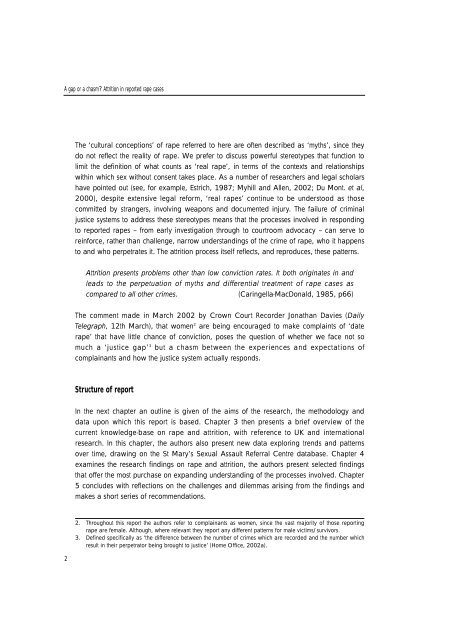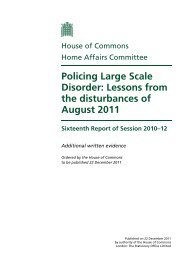A gap or a chasm? - National Police Library Online Catalogue
A gap or a chasm? - National Police Library Online Catalogue
A gap or a chasm? - National Police Library Online Catalogue
You also want an ePaper? Increase the reach of your titles
YUMPU automatically turns print PDFs into web optimized ePapers that Google loves.
A <strong>gap</strong> <strong>or</strong> a <strong>chasm</strong>? Attrition in rep<strong>or</strong>ted rape cases<br />
2<br />
The ‘cultural conceptions’ of rape re f e rred to here are often described as ‘myths’, since they<br />
do not reflect the reality of rape. We prefer to discuss powerful stereotypes that function to<br />
limit the definition of what counts as ‘real rape’, in terms of the contexts and re l a t i o n s h i p s<br />
within which sex without consent takes place. As a number of re s e a rchers and legal scholars<br />
have pointed out (see, f<strong>or</strong> example, Estrich, 1987; Myhill and Allen, 2002; Du Mont. et al,<br />
2000), despite extensive legal re f o rm, ‘real rapes’ continue to be understood as those<br />
committed by strangers, involving weapons and documented injury. The failure of criminal<br />
justice systems to address these stereotypes means that the processes involved in re s p o n d i n g<br />
to re p o rted rapes – from early investigation through to court room advocacy – can serve to<br />
re i n f o rce, rather than challenge, narrow understandings of the crime of rape, who it happens<br />
to and who perpetrates it. The attrition process itself reflects, and re p roduces, these patterns.<br />
Attrition presents problems other than low conviction rates. It both <strong>or</strong>iginates in and<br />
leads to the perpetuation of myths and differential treatment of rape cases as<br />
compared to all other crimes. (Caringella-MacDonald, 1985, p66)<br />
The comment made in March 2002 by Crown Court Rec<strong>or</strong>der Jonathan Davies (D a i l y<br />
Telegraph, 12th March), that women 2 are being encouraged to make complaints of ‘date<br />
rape’ that have little chance of conviction, poses the question of whether we face not so<br />
much a ‘justice <strong>gap</strong>’ 3 but a <strong>chasm</strong> between the experiences and expectations of<br />
complainants and how the justice system actually responds.<br />
Structure of rep<strong>or</strong>t<br />
In the next chapter an outline is given of the aims of the research, the methodology and<br />
data upon which this re p o rt is based. Chapter 3 then presents a brief overview of the<br />
c u rrent knowledge-base on rape and attrition, with re f e rence to UK and intern a t i o n a l<br />
research. In this chapter, the auth<strong>or</strong>s also present new data expl<strong>or</strong>ing trends and patterns<br />
over time, drawing on the St Mary’s Sexual Assault Referral Centre database. Chapter 4<br />
examines the research findings on rape and attrition, the auth<strong>or</strong>s present selected findings<br />
that offer the most purchase on expanding understanding of the processes involved. Chapter<br />
5 concludes with reflections on the challenges and dilemmas arising from the findings and<br />
makes a sh<strong>or</strong>t series of recommendations.<br />
2. Throughout this rep<strong>or</strong>t the auth<strong>or</strong>s refer to complainants as women, since the vast maj<strong>or</strong>ity of those rep<strong>or</strong>ting<br />
rape are female. Although, where relevant they rep<strong>or</strong>t any different patterns f<strong>or</strong> male victims/surviv<strong>or</strong>s.<br />
3. Defined specifically as ‘the difference between the number of crimes which are rec<strong>or</strong>ded and the number which<br />
result in their perpetrat<strong>or</strong> being brought to justice’ (Home Office, 2002a).

















